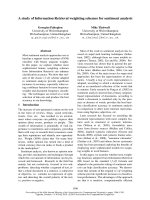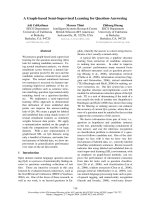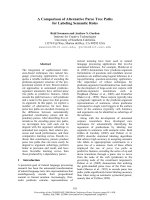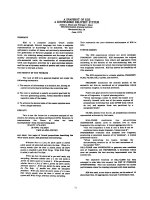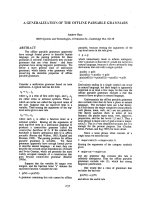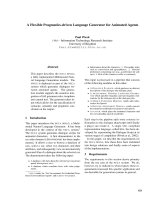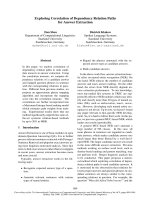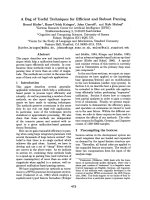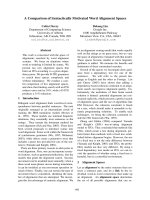Báo cáo khoa học: "A Suite of Shallow Processing Tools for Portuguese: LX-Suite" doc
Bạn đang xem bản rút gọn của tài liệu. Xem và tải ngay bản đầy đủ của tài liệu tại đây (66.15 KB, 4 trang )
A Suite of Shallow Processing Tools for Portuguese:
LX-Suite
Ant
´
onio Branco
Department of Informatics
University of Lisbon
Jo
˜
ao Ricardo Silva
Department of Informatics
University of Lisbon
Abstract
In this paper we present LX-Suite, a set
of tools for the shallow processing of Por-
tuguese. This suite comprises several
modules, namely: a sentence chunker, a
tokenizer, a POS tagger, featurizers and
lemmatizers.
1 Introduction
The purpose of this paper is to present LX-Suite,
a set of tools for the shallow processing of Por-
tuguese, developed under the TagShare
1
project by
the NLX Group.
2
The tools included in this suite are a sentence
chunker; a tokenizer; a POS tagger; a nominal fea-
turizer; a nominal lemmatizer; and a verbal featur-
izer and lemmatizer.
These tools were implemented as autonomous
modules. This option allows to easily replace any
of the modules by an updated version or even by a
third-party tool. It also allows to use any of these
tools separately, outside the pipeline of the suite.
The evaluation results mentioned in the next
sections have been obtained using an accurately
hand-tagged 280, 000 token corpus composed of
newspaper articles and short novels.
2 Sentence chunker
The sentence chunker is a finite state automaton
(FSA), where the state transitions are triggered
by specified character sequences in the input, and
the emitted symbols correspond to sentence (<s>)
and paragraph (<p>) boundaries. Within this
setup, a transition rule could define, for example,
1
2
NLX—Natural Language and Speech Group, at the De-
partment of Informatics of the University of Lisbon, Faculty
of Sciences:
that a period, when followed by a space and a cap-
ital letter, marks a sentence boundary:
“· · ·. A· · ·” → “· · ·.</s><s>A· · ·”
Being a rule-based chunker, it was tailored to
handle orthographic conventions that are specific
to Portuguese, in particular those governing dia-
log excerpts. This allowed the tool to reach a very
good performance, w ith values of 99.95% for re-
call and 99.92% for precision.
3
3 Tokenizer
Tokenization is, for the most part, a simple task,
as the whitespace character is used to mark most
token boundaries. Most of other cases are also
rather simple: Punctuation symbols are separated
from words, contracted forms are expanded and cl-
itics in enclisis or mesoclisis position are detached
from verbs. It is worth noting that the first ele-
ment of an expanded contraction is marked with
a symbol (+) indicating that, originally, that token
occurred as part of a contraction:
4
um, dois →|um|,|dois|
da →|de+|a|
viu-o →|viu|-o|
In what concerns Portuguese, the non-trivial as-
pects of tokenization are found in the handling of
ambiguous strings that, depending on their POS
tag, may or may not be considered a contrac-
tion. For example, the word deste can be tok-
enized as the single token |deste| if it occurs
as a verb (Eng.: [you] gave) or as the two tokens
|de+|este| if it occurs as a contraction (Eng.:
of this).
3
For more details, see (Branco and Silva, 2004).
4
In these examples the | symbol will be used to mark
token boundaries more clearly.
179
It is worth noting that this problem is not a mi-
nor issue, as these strings amount to 2% of the cor-
pus that was used and any tokenization error will
have a considerable negative influence on the sub-
sequent steps of processing, such as POS tagging.
To resolve the issue of ambiguous strings, a
two-stage tokenization strategy is used, where the
ambiguous strings are not immediately tokenized.
Instead, the decision counts on the contribution of
the POS tagger: The tagger must fi rst be trained
on a version of the corpus where the ambiguous
strings are not tokenized, and are tagged with a
composite tag when occurring as a contraction (for
example P+DEM for a contraction of a preposition
and a demonstrative). The tagger then runs over
the text and assigns a simple or a composite tag to
the ambiguous strings. A second pass with the to-
kenizer then looks for occurrences of tokens with
a composite tag and splits them:
deste/V →|deste/V|
deste/P+DEM →|de+/P|este/DEM|
This approach allowed us to successfully re-
solve 99.4% of the ambiguous strings. This is a
much better value than the baseline 78.20% ob-
tained by always considering that the ambiguous
strings are a contraction.
5
4 POS tagger
For the POS tagging task we used Brant’s TnT tag-
ger (Brants, 2000), a very efficient statistical tag-
ger based on Hidden Markov Models.
For training, we used 90% of a 280, 000 token
corpus, accurately hand-tagged with a tagset of ca.
60 tags, with inflectional feature values left aside.
Evaluation showed an accuracy of 96.87% for
this tool, obtained by averaging 10 test runs over
different 10% contiguous portions of the corpus
that were not used for training.
The POS tagger we developed is currently the
fastest tagger for the Portuguese language, and it
is in line with state-of-the-art taggers for other lan-
guages, as discussed in (Branco and Silva, 2004).
5 Nominal featurizer
This tool assigns feature value tags for inflection
(Gender and Number) and degree (Diminutive,
Superlative and C omparative) to words from nom-
inal morphosyntactic categories.
5
For further details see (Branco and Silva, 2003).
Such tagging is typically done by a POS tagger,
by using a tagset where the base POS tags have
been extended with feature values. However, this
increase in the number of tags leads to a lower tag-
ging accuracy due to the data-sparseness problem.
With our tool, we explored what could be gained
by having a dedicated tool for the task of nominal
featurization.
We tried several approaches to nominal featur-
ization. Here we report on the rule-based approach
which is the one that better highlights the difficul-
ties in this task.
For this tool, we built on morphological regular-
ities and used a set of rules that, depending on the
word termination, assign default feature values to
words. Naturally, these rules were supplemented
by a list of exceptions, which was collected by us-
ing an machine readable dictionary (MRD) that al-
lowed us to search words by termination.
Nevertheless, this procedure is still not enough
to assign a feature value to every token. The
most direct reason is due to the so-called invari-
ant words, which are lexically ambiguous with re-
spect to feature values. For example, the Common
Noun ermita (Eng.: hermit) can be masculine or
feminine, depending on the occurrence. By simply
using termination rules supplemented with excep-
tions, such words will always be tagged with un-
derspecified feature values:
6
ermita/?S
To handle such cases the featurizer makes use of
feature propagation. With this mechanism, words
from closed classes, for which we know their fea-
ture values, propagate their values to the words
from open classes following them. These words,
in turn, propagate those features to other words:
o/MS ermita/MS humilde/MS
Eng.: the-MS humble-MS hermit-MS
but
a/FS ermita/FS humilde/FS
Eng.: the-FS humble-FS hermit-FS
Special care must be taken to avoid that feature
propagation reaches outside NP boundaries. For
this purpose, some sequences of POS categories
block feature propagation. In the example below,
a PP inside an NP context, azul (an “invariant”
6
Values: M:masculine, F:feminine, S:singular, P: plural
and ?:undefined.
180
adjective) might agree with faca or with the pre-
ceding word, ac¸o. To prevent mistakes, propaga-
tion from ac¸o to azul should be blocked.
faca/FS de ac¸o/MS azul/FS
Eng.: blue (steel knife)
or
faca/FS de ac¸o/MS azul/MS
Eng.: (blue steel) knife
For the sake of comparability with other pos-
sible similar tools, we evaluated the featurizer
only over Adjectives and Common Nouns: It has
95.05% recall (leaving ca. 5% of the tokens with
underspecified tags) and 99.05% precision.
7
6 Nominal lemmatizer
Nominal lemmatization consists in assigning to
Adjectives and Common Nouns a normalized
form, typically the masculine singular if available.
Our approach uses a list of transformation rules
that helps changing the termination of the words.
For example, one states that any word ending in
ta should have that ending transformed into to:
gata ([female] cat)
→ gato ([male] cat)
There are, however, exceptions that must be ac-
counted for. The word porta, for example, is a
feminine common noun, and its lemma is porta:
porta (door, feminine common noun)
→ porta
Relevant exceptions like the one above were
collected by resorting to a MRD that allowed to
search words on the basis of their termination. Be-
ing that dictionaries only list lemmas (and not in-
flected forms), it is possible to search for words
with terminations matching the termination of in-
flected words (for example, words ending in ta).
Any word found by the search can thus be consid-
ered as an exception.
A major difficulty in this task lies in the list-
ing of exceptions when non-inflectional affixes are
taken into account. As an example, lets con-
sider again the word porta. This word is an
exception to the rule that transforms ta into to.
As expected, this word can occur prefixed, as
in superporta. Therefore, this derived word
7
For a much more extensive analysis, including a compar-
ison with other approaches, see (Branco and Silva, 2005a).
should also appear in the list of exceptions to pre-
vent it from being lemmatized into superporto
by the rule. However, proceeding like this for ev-
ery possible prefix leads to an explosion in the
number of exceptions. To avoid this, a mechanism
was used that progressively strips prefixes from
words while checking the resulting word forms
against the list of exceptions:
supergata
gata (apply rule)
→ supergato
but
superporta
porta (exception)
→ superporta
A similar problem arises when tackling words
with suffixes. For instance, the suffix -zinho
and its inflected forms (-zinha, -zinhos and
-zinhas) are used as diminutives. These suf-
fixes should be removed by the lemmatization pro-
cess. However, there are exceptions, such as the
word vizinho (Eng.: neighbor) which is not a
diminutive. This word has to be listed as an excep-
tion, together with its inflected forms (vizinha,
vizinhos and vizinhas), w hich again leads
to a great increase in the number of exceptions. To
avoid this, only vizinho is explicitly listed as an
exception and the inflected forms of the diminu-
tive are progressively undone while looking for an
exception:
vizinhas (feminine plural)
vizinha (feminine singular)
vizinho (exception)
→ vizinho
To ensure that exceptions will not be over-
looked, when both these mechanisms work in par-
allel one must follow all possible paths of affix re-
moval. An heuristic chooses the lemma as being
the result found in the least number of steps.
8
To illustrate this, consider the word antena
(Eng.: antenna). Figure 1 shows the paths fol-
lowed by the lemmatization algorithm when it is
faced with antenazinha (Eng.: [small] an-
tenna). Both ante- and -zinha are possible
affixes. In a first step, two search branches are
opened, the first where ante- is removed and
the second where -zinha is transformed into
8
This can be seen as following a rationale similar to Karls-
son’s (1990) local disambiguation procedure.
181
antenazinha
nazinha antenazinho
nazinho nazinho
antena
na
no
na
no
0
1
2
3
4
Figure 1: Lemmatization of antenazinha
-zinho. The search proceeds under each branch
until no transformation is possible, or an exception
has been found. The end result is the “leaf node”
with the shortest depth which, in this example, is
antena (an exception).
This branching might seem to lead to a great
performance penalty, but only a few words have
affixes, and most of them have only one, in which
case there is no branching at all.
This tool evaluates to an accuracy of 94.75%.
9
7 Verbal featurizer and lemmatizer
To each verbal token, this tool assigns the corre-
sponding lemma and tag with feature values for
Mood, Tense, Person and Number.
The tool uses a list of rules that, depending on
the termination of the word, assign all possible
lemma-feature pairs. The word diria, for exam-
ple, is assigned the following lemma-feature pairs:
diria
→ dizer,Cond-1ps
→ dizer,Cond-3ps
→ diriar,PresInd-3ps
→ diriar,ImpAfirm-2ps
Currently, this tool does not attempt to disam-
biguate among the proposed lemma-feature pairs.
So, each verbal token will be tagged with all its
possible lemma-feature pairs.
The tool was evaluated over a list with ca.
800, 000 verbal forms. It achieves 100% preci-
sion, but at 50% recall, as half of those forms
are ambiguous and receive more than one lemma-
feature pair.
9
For further details, see (Branco and Silva, 2005b).
8 Final Remarks
So far, LX-Suite has mostly been used in-house
for projects being developed by the NLX Group.
It is being used in the GramaXing project,
where a computational core grammar for deep lin-
guistic processing of Portuguese is being devel-
oped under the Delphin initiative.
10
In collaboration with C LUL,
11
and under the
TagShare project, LX-Suite is being used to help
in the building of a corpus of 1 million accurately
hand-tagged tokens, by providing an initial, high-
quality tagging which is then manually corrected.
It is also used for the QueXting project, whose
aim is to make available a question answering sys-
tem on the Portuguese Web.
There is an on-line demo of LX-Suite located
at . This
on-line version of the suite is a partial demo,
as it currently only includes the modules up to
the POS tagger. B y the end of the TagShare
project (mid-2006), all the other modules de-
scribed in this paper are planned to have been
included. Additionally, the verbal featurizer and
lemmatizer can be tested as a standalone tool at
.
Future work will be focused on extending the
suite with new tools, such as a named-entity rec-
ognizer and a phrase chunker.
References
Branco, Ant´onio and Jo˜ao Ricardo Silva. 2003. Con-
tractions: breaking the tokenization-tagging circu-
larity. LNAI 2721. pp. 167–170.
Branco, Ant´onio and Jo˜ao Ricardo Silva. 2004. Evalu-
ating Solutions for the Rapid Development of State-
of-the-Art POS Taggers for Portuguese. In Proc. of
the 4th LREC. pp. 507–510.
Branco, Ant´onio and Jo˜ao Ricardo Silva. 2005a. Ded-
icated Nominal Featurization in Portuguese. ms.
Branco, Ant´onio and Jo˜ao Ricardo Silva. 2005b. Nom-
inal Lemmatization with Minimal Word List. ms.
Brants, T horsten. 2000. TnT - A Statistical Part-of-
Speech Tagger. In Pr oc. o f the 6th ANLP.
Karlsson, Fred 1990. Constraint Grammar as a
Framework for Parsing Running Text. In Proc. of
the 13th COLING.
10
11
Linguistics Center of the University of Lisbon
182

